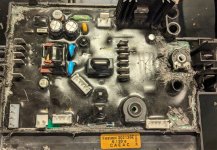I have a 230V CTL 26 E, build year 2020 that when turned on, gave some arcing and a puff of white smoke and doesn't give a sign of life ever since.
I have taken out the circuit board and found nothing visibly wrong. No blown caps, no burned parts. The problem however... is that it is encased in epoxy (?). I have removed a bunch of it with a soldering iron, however, the PCB has some holes in it and the epoxy has flown underneath too, so I don't know how to free the board from it's 'basket'.
The potentiometer behind the main switch did have a funny smell. I have removed the epoxy around it and removed it's cap. It is from PIHER (probaby a PT15) and market 50K842M. I cannot match that to their naming topology however. I did measure the potentiometer and it ranges from 0 Ohm to about 14 kOhm. That is however 'in circuit', so that will most likely distort the measurement. Otherwise I would have expect 0 to 50 kOhm. This potentiometer tell the CTL to either be in auto or manual-on.
The problem is however, I don't have a diagram and the epoxy makes it impossible to draw one myself. So if anyone has it, or has had a similar problem before (and a solution) I would be happy to hear it.
I do have another (older) 230V CTL 26 E that I can compare measurements with. However, I am somewhat reluctant to swap out the PCB 1:1 in case the motor blew the PCB. The older PCB does have significantly less epoxy on it, but the entire surface is still invisible.
I could of course just buy a new PCB at €125 but for my wallet' and environments sake I'd rather just replace the broken parts. Like that potentiometer is only ~70 cents.
This is where I am at now;
[attachimg=1]
I have taken out the circuit board and found nothing visibly wrong. No blown caps, no burned parts. The problem however... is that it is encased in epoxy (?). I have removed a bunch of it with a soldering iron, however, the PCB has some holes in it and the epoxy has flown underneath too, so I don't know how to free the board from it's 'basket'.
The potentiometer behind the main switch did have a funny smell. I have removed the epoxy around it and removed it's cap. It is from PIHER (probaby a PT15) and market 50K842M. I cannot match that to their naming topology however. I did measure the potentiometer and it ranges from 0 Ohm to about 14 kOhm. That is however 'in circuit', so that will most likely distort the measurement. Otherwise I would have expect 0 to 50 kOhm. This potentiometer tell the CTL to either be in auto or manual-on.
The problem is however, I don't have a diagram and the epoxy makes it impossible to draw one myself. So if anyone has it, or has had a similar problem before (and a solution) I would be happy to hear it.
I do have another (older) 230V CTL 26 E that I can compare measurements with. However, I am somewhat reluctant to swap out the PCB 1:1 in case the motor blew the PCB. The older PCB does have significantly less epoxy on it, but the entire surface is still invisible.
I could of course just buy a new PCB at €125 but for my wallet' and environments sake I'd rather just replace the broken parts. Like that potentiometer is only ~70 cents.
This is where I am at now;
[attachimg=1]

